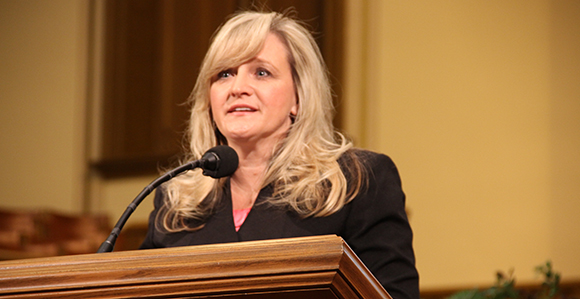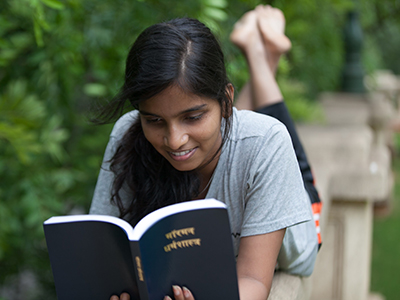“Pioneers in Every Land” Lecture Focuses on India
Contributed By R. Scott Lloyd, Church News staff writer

Taunalyn Rutherford presents her Pioneers in Every Land lecture on “Voices of Latter-day Pioneers in India” on March 12, 2015, in the Assembly Hall on Temple Square.
Article Highlights
- Sister Rutherford developed a deep love for India when she visited in 1986 with a BYU singing group.
- The presentation highlighted several Indian pioneers, including Paul Thiruthuvadoss, who found the gospel in 1954 through a pamphlet in a used book store.
“I didn’t serve a mission in India; I’m not from India, but I am a witness of God’s love for India, the people there, and what He is doing there.” —Taunalyn Rutherford
Related Links
Taunalyn Rutherford fell in love with India while she was a student performing there on tour with Brigham Young University’s singing group the Young Ambassadors in 1986. Her affection deepened in 2013, when she spent a month in that country interviewing and interacting with faithful Latter-day Saints who have helped establish and develop the Church there in modern times.
Her presentation, “Subcontinent to Salt Lake City: Voices of Latter-day Pioneers in India,” was the second installment in the monthly Pioneers in Every Land lecture series offered by the Church History Library. She spoke March 12 in the Assembly Hall on Temple Square in Salt Lake City.
“I want to acknowledge the fact that I am speaking from a position of privilege, from a position of an outsider,” said Sister Rutherford, a doctoral candidate in religious studies at Claremont Graduate University in California who is writing her dissertation on the Church in India. “I didn’t serve a mission in India; I’m not from India, but I am a witness of God’s love for India, the people there, and what He is doing there.”
She spoke of being with the Young Ambassadors in India in 1986, when the group spent a day with the famous Catholic humanitarian Mother Teresa.
“We went to her homes for the dying, we went to her orphanage, we saw her minister in the streets, and, at the end of the day, she took us back to her convent, and she said, ‘Would you like to sing to Jesus?’
“And of course, we said yes, and we sang, ‘I Am a Child of God.’ Standing in the presence of a true disciple of Christ with the truth was life-changing for me. I’ve never been the same. … I wondered what God’s plan was for these children. Well, I’ve been blessed to be able to see just a little bit of what He is to them.”

Members in Hyderabad, India.

Young woman reading the Book of Mormon in Mumbai, India.
The modern era of the Church in India started not long after that, with the first missionaries being sent to the country. But prior to that, she said, there were some modern-day Mormon pioneers in India who found the Church “organically,” meaning on their own, without having been introduced to it by missionaries.
One of these was Paul Thiruthuvadoss from Coimbatore, who in 1954 found a yellowed Church tract in a used book store and, reading it, became convinced of its truthfulness, Sister Rutherford said. In 1957, he requested baptism after having read the Book of Mormon five times. In 1964, Elder Gordon B. Hinckley, then of the Quorum of the Twelve Apostles, visited him with President Jay A. Quealy of the Southern Far East Mission. Finally, on February 5, 1965, President Quealy baptized him, thus beginning the modern-day era of the Church in India.
“At the time he was baptized, there were two missionaries sent for six months,” Sister Rutherford recounted. “And basically, after that six months, Brother Thiruthuvadoss was on his own. When the Church finally sent missionaries back, it was 1973, and there were 225 members. Most of them had been taught by Brother Thiruthuvadoss.”
Sister Rutherford said she was fortunate to visit Coimbatore on a day when a branch party was being held. “So there, as I was surrounded by this tremendous branch, it was one of the best days of my life.”
The mission there is English speaking, but the branch is one in which the members speak Tamil. Sister Rutherford spoke of three girls who approached her while she was there and said in broken English, “We’re preparing for missions; do you have any advice for us?”
Sister Rutherford said she suddenly felt extremely inadequate. “Fortunately, it came into my head what I had heard a returned missionary tell me in an interview. He said, ‘I read the Book of Mormon in English until I knew English.’ And so I suggested, ‘Read the Book of Mormon in English.’ They looked at me as if to say, ‘We’re already doing that; thanks, Sister.’ But anyway, it’s exciting to see sister missionaries there.”
On a visit to Bangalore, Sister Rutherford met Robert William, a member of the presidency of the India Bangalore Mission. His family joined the Church during the Thiruthuvadoss era in Coimbatore. His wife-to-be joined the Church in 1990 and became one of the first five sister missionaries to serve in India.
After he was engaged, a local Church leader counseled Brother William to get married in India and then to save up money so they could go and be sealed in a temple.
“Sister William said, ‘No, we will get married in the temple,’ and that’s what they did. They have been richly blessed, this family.”
She quoted Brother William as saying, “Ever since we put our foot into the temple, I think our whole life was transformed.”
Sister Rutherford spoke of the organization of the Hyderabad India Stake, the first in the country, on May 27, 2012, with John Gutty as the stake president. The Gutty family joined the Church about 10 years after the Church was established there.
“It took a while for John to join the Church, and then he was less active for a while, until his branch president said to come join,” Sister Rutherford said. He began by playing volleyball in the branch and soon accepted a calling as the branch librarian. Two weeks later, at age 16, he was called to be the Young Men president.
“He was in the district presidency and then was put in as branch president for six months before the stake was organized,” she said. “He said that for six months he couldn’t sleep. He kept thinking about what he needed to do to help organize the stake, to prepare to make it a successful stake, how to make the stake go forward. And then, lo and behold, he was called as the stake president.”
The free lectures are held generally on the second Thursday of each month at 7:00 p.m. in the Assembly Hall. Learn more about upcoming lectures. Watch highlights of lectures you may have missed.
